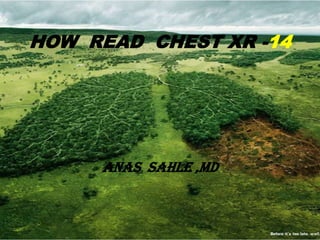How read chest xr 14
- 1. HOW READ CHEST XR -14 ANAS SAHLE ,MD
- 2. Brief review
- 3. POSITION PA AP QUALITY ROTATION PENETRATION INSPIRATION LESION OPACIT OPACITY Homo Heterogenous Wellill defined Zone Centralperipher Silhouet sign al Y Necrotic PATCHY HILUMMEDIASTINAL NODULE Central deviasionwided MASS COSTO-PHRENIC ANGEL Freeoblitern CAVITARY OTHER INFILTIRATION Bone soft tissuediaphragm
- 4. Consolidation Infection causes Non-infection causes Broncho- WEGNER Cardiac Pneumonia Lymphoma alveolar COP Sarcoid disease failure carcinoma
- 5. Solitary Pulmonary Nodule(SPN) Appearance Margin Calcification cavitation Comparison with a Size previous x-ray to >8mm <8mm Assess growth over time. Location Upperhillar zone Lowerbasesup-pleural Associated abnormalities Lymph node enlargement Rib destruction/erosion
- 6. Cavitary lesion Air + Air-fluid level Air only tissue Wall thickness Straight Wavy Thick Thin 1. Fungal ball. 2. Rupture hydatid cyct site 3. Necrotic tumor ruptured 4. Blood glot Hydatid Abscess Irregular Regular Peripheral Central inner wall inner wall cyst Emphesemato Cavitating Chronic us pneumatoc neoplasm abscess ele bulla
- 7. LINEAR PATTERN LINEAR PATTERN LEFT VENTRICULAR FAILURE Perihilar and peripheral basal septal lines, changes acutely and resolves with diuretics Normal ageing Coarsening of lung markings in lower zones, no change on review of recent films Lymphangitis Coarse nodular and linear thickening of markings, known malignancy, often associated with pleural effusion, rapid clinical deterioration of patient
- 8. LINEAR PATTERN LINEAR PATTERN Atelectasis Short thin lines, often basal, new on review of previous films Subsegmental Longer thicker bands, often perihilar or basal, collapse suggest recent infection or infarction Scarring Any length, persist over time unchanged Fibrosis Volume loss is key, persists over time
- 9. Causes of fibrosis Mid zone lung Lower zone lung Upper zone lung tuberculosis Drug indused fibrosis sarcoidosis (most common) Chronic extrinsic allergic UIP alveolitis Radio-therapy Asbestose-related fibrosis Ankylosing spondylitis Progressive massive fibrosis histoplasmosis
- 10. Mediastinum
- 11. MEDIASTINAL ANATOMY Superior: Upper of T4 Inferior: Lower of T4( T4-T8)







































































